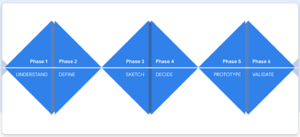Public:Product Design Sprint: Difference between revisions
No edit summary |
No edit summary |
||
| Line 11: | Line 11: | ||
In this phase the business opportunity, the audience, the competition & the value proposition are discovered; and metrics of success are defined. | In this phase the business opportunity, the audience, the competition & the value proposition are discovered; and metrics of success are defined. | ||
In simple words, the problem (that's needed to be solved) will be picked in this phase.<ref>https:// | In simple words, the problem (that's needed to be solved) will be picked in this phase.<ref>Google Venture's: [https://youtu.be/K2vSQPh6MCE?feature=shared Sprint Process in 90 Seconds]</ref> Hence, Jake Knapp calls this phase as Map.<ref name=":0">[https://www.thesprintbook.com/the-design-sprint The Sprint Book: The Design Sprint]</ref> | ||
Google alternatively divides this Phase in 2 phases as Understand<ref>https://designsprintkit.withgoogle.com/methodology/phase1-understand</ref> & Define<ref>https://designsprintkit.withgoogle.com/methodology/phase2-define</ref>. | Google alternatively divides this Phase in 2 phases as Understand<ref>[https://designsprintkit.withgoogle.com/methodology/phase1-understand Google Design Sprint Kit: Phase 1 - Understanding]</ref> & Define<ref>[https://designsprintkit.withgoogle.com/methodology/phase2-define Google Design Sprint Kit: Phase 2 - Define]</ref>. | ||
=== Sketch [or Ideate] === | === Sketch [or Ideate] === | ||
In this phase broad range of Ideas are suggested by Design Sprint Team as a Solution for the Problem selected in the Brainstorm Phase. | In this phase broad range of Ideas are suggested by Design Sprint Team as a Solution for the Problem selected in the Brainstorm Phase. | ||
These ideas are shared in the form of rough sketches, hence this phase is also known as Sketch.<ref>https://designsprintkit.withgoogle.com/methodology/phase3-sketch</ref><ref name=":0" /> | These ideas are shared in the form of rough sketches, hence this phase is also known as Sketch.<ref>[https://designsprintkit.withgoogle.com/methodology/phase3-sketch Google Design Sprint Kit: Phase 3 - Sketch]</ref><ref name=":0" /> | ||
=== Decide === | === Decide === | ||
In this phase, the Design Sprint team finalizes the direction or concept to be prototyped, by selecting from the solutions suggested in Ideate phase.<ref>https://designsprintkit.withgoogle.com/methodology/phase4-decide</ref> | In this phase, the Design Sprint team finalizes the direction or concept to be prototyped, by selecting from the solutions suggested in Ideate phase.<ref>[https://designsprintkit.withgoogle.com/methodology/phase4-decide Google Design Sprint Kit: Phase 4 - Decide]</ref> | ||
=== Prototype === | === Prototype === | ||
| Line 34: | Line 34: | ||
* If the concept is not validated, then the prototype will be sent for improvement accordingly. This will start a new sprint. | * If the concept is not validated, then the prototype will be sent for improvement accordingly. This will start a new sprint. | ||
Due to it's nature this phase is also known as Validate Phase by Google.<ref>https://designsprintkit.withgoogle.com/methodology/phase6-validate</ref> | Due to it's nature this phase is also known as Validate Phase by Google.<ref>[https://designsprintkit.withgoogle.com/methodology/phase6-validate Google Design Sprint Kit: Phase 6 - validate]</ref> | ||
Revision as of 14:41, 29 May 2024
A Product Design Sprint is a 5 days, five-phase process (one day for each phase) that uses design thinking with the aim of reducing the risk when bringing a new product, service or a feature to the market.[1]
Phases of a Design Sprint


Map [or Brainstorm]
In this phase the business opportunity, the audience, the competition & the value proposition are discovered; and metrics of success are defined.
In simple words, the problem (that's needed to be solved) will be picked in this phase.[2] Hence, Jake Knapp calls this phase as Map.[3]
Google alternatively divides this Phase in 2 phases as Understand[4] & Define[5].
Sketch [or Ideate]
In this phase broad range of Ideas are suggested by Design Sprint Team as a Solution for the Problem selected in the Brainstorm Phase.
These ideas are shared in the form of rough sketches, hence this phase is also known as Sketch.[6][3]
Decide
In this phase, the Design Sprint team finalizes the direction or concept to be prototyped, by selecting from the solutions suggested in Ideate phase.[7]
Prototype
In this phase, the Design Sprint team will work together to create a prototype of the concept finalized in the Decide phase.
Test [or Validate]
In this phase, the prototype is shared with the audience (discovered in the Brainstorm phase) to gather their feedback & response through observations & interview.
Based on the outcome of this phase:
- If the concept is validated, then the prototype will be sent for development.
- If the concept is not validated, then the prototype will be sent for improvement accordingly. This will start a new sprint.
Due to it's nature this phase is also known as Validate Phase by Google.[8]
References
- ↑ Wikipedia: Design sprint
- ↑ Google Venture's: Sprint Process in 90 Seconds
- ↑ 3.0 3.1 The Sprint Book: The Design Sprint
- ↑ Google Design Sprint Kit: Phase 1 - Understanding
- ↑ Google Design Sprint Kit: Phase 2 - Define
- ↑ Google Design Sprint Kit: Phase 3 - Sketch
- ↑ Google Design Sprint Kit: Phase 4 - Decide
- ↑ Google Design Sprint Kit: Phase 6 - validate
